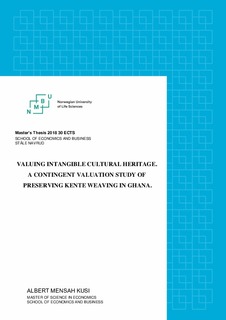| dc.description.abstract | Ghanaian culture has a long and proud textile tradition as one of the most significant features. Kente cloth as an intangible culture heritage has become the best known and most widely recognized of all African textiles. It has a unique ability to induce powerful emotions and symbolizes some of the fundamental human ideas ever imagined in Africa, within Ghana, and can cut across ethnic divisions and inculcates a sense of national pride. While there are many studies valuing tangible cultural heritage, there are only a few valuation studies of intangible cultural heritage and to my knowledge none in a developing country context. This study adds to this scarce literature by documenting the economic value of preserving kente weaving in terms of households’ willingness-to-pay (WTP) for establishing kente national centres in Ghana.
A random sample of 415 households in the cities of Accra and Kumasi were interviewed inperson in a Contingent Valuation (CV) survey about their knowledge, attitude, kente buying behaviour, and WTP to preserve kente weaving by establishing kente national centres. Mean WTP/household/year was 47 GHS (10.4 US$), which constituted 0.3% of the mean annual household income.
Respondents who are young, female, have higher education and say they are likely to visit kente centres have a significantly higher WTP. Further, respondents with a higher level of knowledge about kente weaving, the interpretation of kente symbols and kente cloth in general, have higher WTP. Also, households in Accra, who live further away from the kente weaving towns are willing to pay more to establish these kente centres than households in Kumasi who live in the kente weaving area. However, public education must be embarked on to create awareness on the need to establish these kente national centres. Only 7.2, 8.7 and 11.8% of the respondents have a high level of knowledge about kente weaving, knowledge in interpretation of kente symbols and about kente cloth in general; respectively. Thus, stakeholders should create national programs to preserve kente weaving. A majority of the respondents (51.3%) said, they are likely to visit the centre if they were to be established. | nb_NO |

